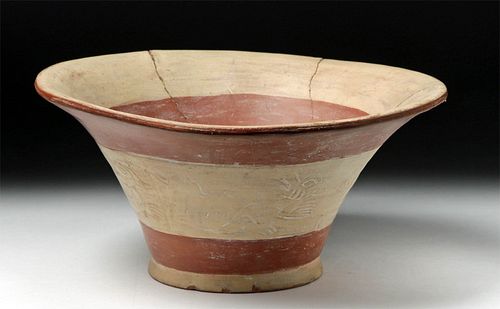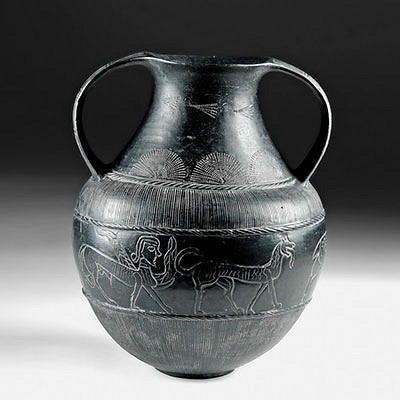Moche Pottery Bichrome Florero - Impressed Designs
Lot 80c
About Seller
Artemis Gallery
686 S Taylor Ave, Ste 106
Louisville, CO 80027
United States
Selling antiquities, ancient and ethnographic art online since 1993, Artemis Gallery specializes in Classical Antiquities (Egyptian, Greek, Roman, Near Eastern), Asian, Pre-Columbian, African / Tribal / Oceanographic art. Our extensive inventory includes pottery, stone, metal, wood, glass and textil...Read more
Estimate:
$400 - $600
Absentee vs Live bid
Two ways to bid:
- Leave a max absentee bid and the platform will bid on your behalf up to your maximum bid during the live auction.
- Bid live during the auction and your bids will be submitted real-time to the auctioneer.
Bid Increments
| Price | Bid Increment |
|---|---|
| $0 | $25 |
| $300 | $50 |
| $1,000 | $100 |
| $2,000 | $250 |
| $5,000 | $500 |
| $10,000 | $1,000 |
| $20,000 | $2,500 |
| $50,000 | $5,000 |
| $100,000 | $10,000 |
| $200,000 | $20,000 |
About Auction
By Artemis Gallery
Sep 17, 2020
Set Reminder
2020-09-17 10:00:00
2020-09-17 10:00:00
America/New_York
Bidsquare
Bidsquare : CLEARANCE - Ancient, Pre-Columbian, Ethno Art
https://www.bidsquare.com/auctions/artemis-gallery/clearance---ancient-pre-columbian-ethno-art-5605
End-of-Summer Clearance sale featuring discounted pricing on antiquities from Egypt, Greece, Italy, and the Near East...plus Viking, Asian, Pre-Columbian, Tribal, Russian Icons, Spanish Colonial, Fine Art, more! Starting prices have been reduced up to 65% from original auction prices. Artemis Gallery info@artemisgallery.com
End-of-Summer Clearance sale featuring discounted pricing on antiquities from Egypt, Greece, Italy, and the Near East...plus Viking, Asian, Pre-Columbian, Tribal, Russian Icons, Spanish Colonial, Fine Art, more! Starting prices have been reduced up to 65% from original auction prices. Artemis Gallery info@artemisgallery.com
- Lot Description
**Originally Listed At $700**
Pre-Columbian, North Coast Peru, Moche III, ca. 400 to 500 CE. A huge, hand-built pottery flared bowl - called a florero (Spanish for "flower pot") - used in Moche ceremonies. Painted in a bichrome palette of russet and cream hues, this highly-burnished vessel is comprised of a flat base, gradually-widening walls, and a signature wide-flared rim. The exterior boasts a decorative register of impressed designs in the form of serpent-tailed mythological creatures with long ears, sinuous limbs, and outstretched tongues. Vessels like these are quite rare due to their size and expert artistry, and this example is of no exception! Size: 11.5" W x 5.5" H (29.2 cm x 14 cm).
Florero bowls were generally reserved for ceremonial usage due to the supposed powers held within which could be employed by only the strongest of shaman. Regarding their use, author Jeffrey Quilter posits that they "perhaps…held materials used in healing. Possibly they were even filled with liquid to serve as divinatory mirrors, somewhat like crystal balls, enabling the user to see into the other world and find a cure" (Quilter, Jeffrey. The Moche of Ancient Peru: Media and Messages. Peabody Museum Press, Cambridge, Massachusetts, 2011, pp. 92). Shamanism and medicine were of the utmost importance to ancient Mesoamerican cultures like the Moche, so certain tools or vessels were created at the behest of the shaman so as to progress the advancement of medicinal remedies as well as to not upset the gods to which these shaman prayed and pleaded.
Provenance: private Andrade collection, New York, New York, USA, acquired 1960's
All items legal to buy/sell under U.S. Statute covering cultural patrimony Code 2600, CHAPTER 14, and are guaranteed to be as described or your money back.
A Certificate of Authenticity will accompany all winning bids.
We ship worldwide and handle all shipping in-house for your convenience.
#131541Repaired from a few large pieces with small chips and light adhesive residue along break lines. Expected surface wear and abrasions commensurate with age, fading to pigmentation, with small chips to base and rim, and a couple of stable hairline fissures, otherwise very good. Light earthen deposits throughout, and impressed designs are still visible.Condition
- Shipping Info
-
All shipping is handled in-house for your convenience. Your invoice from Artemis Gallery will include shipping calculation instructions. If in doubt, please inquire BEFORE bidding for estimated shipping costs for individual items.
-
- Buyer's Premium



 EUR
EUR CAD
CAD AUD
AUD GBP
GBP MXN
MXN HKD
HKD CNY
CNY MYR
MYR SEK
SEK SGD
SGD CHF
CHF THB
THB
















